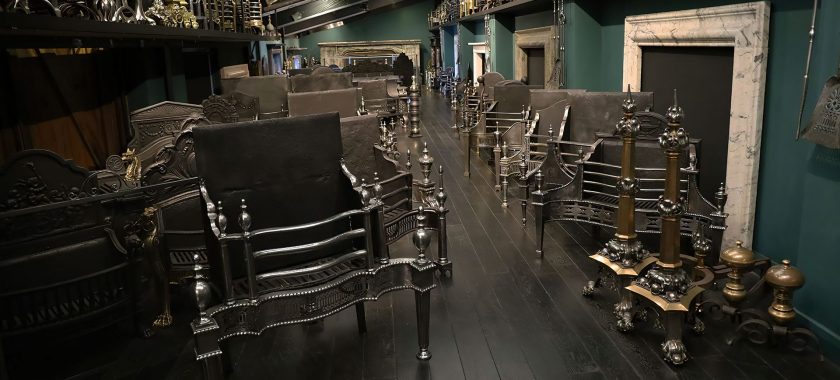In the realm of antique fire grates, the sarcophagus grate stands out for its formidable design. Resembling the elaborate coffins of ancient Egyptian Pharaohs, these grates are typically made from cast iron, incorporating elements of polished steel and brass. An exemplar from our collection demonstrates these features.
The design of this grate, with its paw feet and brass embellishments, is reminiscent of the enigmatic allure of ancient Egypt. The fascination with Egyptian motifs in fire grates during the Regency period in England may seem anachronistic given the desert climate of Egypt, where such items were unnecessary. However, the trend aligns with the widespread enthusiasm for ancient Egyptian art and architecture during this era.
The Regency period, spanning from 1811 to 1820, is associated with the tenure of George, Prince of Wales, who governed in place of his father, King George III, during the latter’s bouts of mental illness. While the official Regency lasted only nine years, the term often refers to a broader span from the 1790s to the 1830s in art and architectural contexts.
This era coincided with Napoleon’s Egyptian campaign in 1798, which introduced European audiences to ancient Egyptian artefacts, sparking a cultural phenomenon known as “Egyptomania.” This fascination is exemplified in the back plate of another piece from our collection, which features sun rays, a motif prevalent in ancient Egyptian art symbolizing the sun god’s benevolence.
The influence of Egyptomania extended beyond fire grates. It inspired themed parties, the construction of the Egyptian Hall in London, and the fashioning of jewelry and furniture with Egyptian motifs. The fire grate, as a focal point of warmth and light in Regency homes, was crafted with artistry and precision.
Advancements in metalwork prior to the Regency period, such as the completion of England’s Iron Bridge in 1779, contributed to the sophistication of fire grate designs. Improved casting techniques allowed for intricate details, as seen in the largest sarcophagus grate in our collection:
The neo-classical movement, which sought to emulate the grandeur of Greek and Roman architecture, also influenced the design of fire grates. This is evident in the symmetry and architectural features of the pieces. A recently sold grate from our collection showcases this influence, with its coffin-like shape and brass acanthus leaves, reminiscent of classical temple decoration.
The arches on the backplate of this piece reveal the influence of another artistic style popular in the Regency period: the Neo-Gothic movement. Artists and architects were inspired by the great medieval castles and Cathedrals with their towering spires and otherworldly elements such as gargoyles and mysterious symbols. Although this was a contrast from neo-classcism, the two styles were both popular, and sometimes we see elements of both.
One of the most sought-after designers from the Regency period is John Skidmore of Skidmore and Sons which he founded in 1793 with his sons Meremoth and Gamaliel whose exotic names perhaps reveal his fascination with ancient mysteries. Another notable fire grate designer from this period is the legendary furniture designer George Bullock, who was so renowned for making sarcophagus grates that they are often referred to as George Bullock grates.
We were able to trace the providence of this Sarcophagus grate from our collection all the way back to its creation by Skidmore and Son.
Like Egyptomania, the neo-classical movement can be viewed as a yearning for the legends and glory of the past. Neo-classical architects were inspired by the power and heroism of ancient Rome and Greece as well as their love of symmetry and order. Perhaps this was appealing given the rather chaotic state of Europe in the late 18th Century. It can also be understood as an effort to push back against the newly emerging Romantic movement which emphasized emotion, individualism, and a connection to nature (values which some felt were having a degenerative effect on society).
A similar nostalgia can also be seen in the overlapping neo-gothic movement (link to neo gothic firegrates page), which represented a desire to return to the magic and morality of the medieval era, to counterbalance the increasing materialist views of science and society that were taking root. Sarcophagus grates are not generally associated with this movement, but neo-gothic features such as pointed arches can be found in some of the pieces in our collection.
And later we see similar phenomena again in the Arts and Crafts (link to arts and craft fire grates) movement, a rejection of mass production and a return to nature-inspired fine craftsmanship. A common theme is a desire to return to something that has been lost, be it stability, morality, or beauty.
Regency pieces inspired by ancient cultures are truly fascinating. Not only do you have a link back to the 18th century, with its exquisite craftsmanship and design, but a further link back to the classical cultures the piece was inspired by. The chains of influence and inspiration that stretch back through the ages are what draw many people to the world of antiques, and sarcophagus grates, the height of 18th-century craftsmanship inspired by the grandeur and mystery of ancient Egypt are a beautiful expression of this phenomenon.









